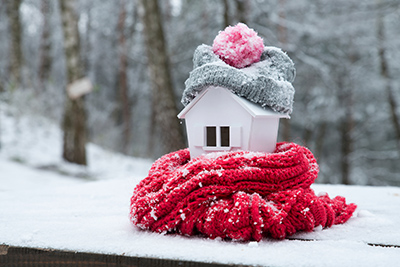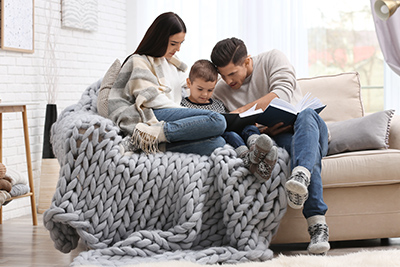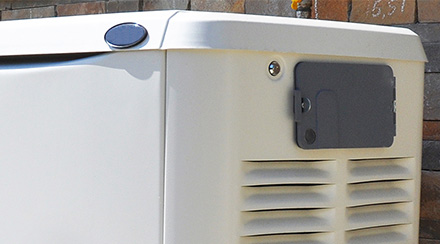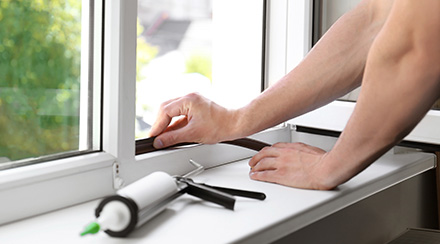What Is the Best Winter Thermostat Setting?
 Space heating consumes more energy than any other system or appliance in most U.S. homes. A study by the Energy Information Administration found that heating accounts for nearly half of the energy use in single-family homes, and 25 percent or more of the energy use in apartments and mobile homes. And since space heating is such an energy-hungry activity, it’s the perfect opportunity to save big by implementing some new energy-efficient habits.
Space heating consumes more energy than any other system or appliance in most U.S. homes. A study by the Energy Information Administration found that heating accounts for nearly half of the energy use in single-family homes, and 25 percent or more of the energy use in apartments and mobile homes. And since space heating is such an energy-hungry activity, it’s the perfect opportunity to save big by implementing some new energy-efficient habits.
What’s the Best Thermostat Setting in Winter?
The U.S. Department of Energy recommends that the best temperature for your heater in winter is 68°F to stay comfortable. But this is only the best temperature when people are home and awake; when a home is unoccupied or at night when all of its residents are sleeping, you can save energy by reducing that setting by 7° to 10°F.
This strategy may be inconvenient if you have a manual thermostat, because you’ll often find yourself waking up in – or coming home to – a house that’s colder than you’d like. But if you install a programmable or smart thermostat, you can maximize your energy savings without sacrificing comfort, and your upgrade will eventually pay for itself.
A programmable thermostat allows you to set a temperature schedule for each day of the week. During the hours when everyone is at school or work, or in the overnight hours when everyone is asleep, you can set the thermostat around 60°F or even a few degrees lower to save energy. And if you program the thermostat for 68°F starting an hour before you usually wake up or return home, you won’t be left freezing while your home warms up.
A smart thermostat takes this concept a step further. These thermostats are connected to the Internet and can be controlled from anywhere with a smartphone or tablet. Heating and cooling schedules can be set with a user-friendly smartphone app, and if you’re away from home and your plans suddenly change, you can start warming your home up early with just a few taps. Some smart thermostats even feature “learning” technology that can automate this process, adjusting your home temperature automatically based on your schedule and habits.
How to Stay Warm Without Increasing Your Heater Temperature

What if 68°F just doesn’t feel warm enough – or what if you want to save more by setting your thermostat even lower? There are lots of ways you can remain comfortable without spending more money on a higher heater temperature.
- Winterize your home. Simple fixes like replacing weather stripping, caulking cracks and filling gaps with spray foam can reduce drafts and help your home retain heat. Bigger projects like adding attic insulation or upgrading your windows can do even more.
- Use your ceiling fans. They’re not just for warm weather – if you reverse your ceiling fan direction to clockwise and operate them at low speed, they will redistribute the warmer air that collects near the ceiling and keep rooms cozier.
- Change your window treatments. Swapping out blinds or lightweight curtains for heavy drapes in the wintertime is a simple approach to sprucing up your home insulation. You can keep them open during the sunny hours for a little extra solar heat, but close them at night to block out the frigid air.
- Dress for the occasion. Who doesn’t love bundling up? Dressing in warm layers and thick socks will make 68°F feel perfectly comfortable. And if you’re just lounging around, wrapping yourself in a blanket can help you set the temperature even lower.
- Add a hat. You lose a lot of your body heat through your head, so pulling on a knitted beanie or other winter hat can make a big difference, even indoors.
- Stay active. Doing a home workout is a great way to raise your body temperature, but even a little bit of activity can help you get that feeling. Motion-detecting video games and table games like ping pong are fun, casual ways to get your blood pumping, or you could break a sweat with a little high-intensity house cleaning.
- Fire up the oven and stove. While you shouldn’t use these appliances for the sole purpose of heating, cooking can add a lot of heat to your home. Whip up a batch of cookies or make a long-simmering soup to enjoy a nice, warm evening in your home kitchen. After turning your oven off, you can leave the door cracked open to release all that excess heat into your home.
- Make a warm drink. Coffee, tea and hot cocoa are delicious ways to keep yourself warm from the inside out.
If you try any of these methods, remember that the point is to stay comfortable while keeping your thermostat set as low as possible. So if you feel too warm, that’s a good thing – just take the thermostat down a few more degrees and rake in the energy savings!
Looking for Something Specific?
Select a category to find resources for topics that interest you.
Select Category

Related Articles:

What to Do Before, During and After Power Outages
With a little knowledge and preparation, you can protect yourself, your home and your belongings during power outages of any duration.
Read Article
How to Choose a Generator for Your Home
Power outages can be miserable, but with the right generator, you can keep your family safe and comfortable until power is restored. Learn how to choose the best generator for your home.
Read Article
Weatherize Your Home for Summer
The extreme heat of summer can really do a number on your energy bills. But if you’re able to invest a little time and money into weatherizing to keep your home cool, you can help yourself and your family remain comfortable at home while still saving energy.
Read ArticleWhat Is the Best Winter Thermostat Setting?
What’s the Best Thermostat Setting in Winter?
The U.S. Department of Energy recommends that the best temperature for your heater in winter is 68°F to stay comfortable. But this is only the best temperature when people are home and awake; when a home is unoccupied or at night when all of its residents are sleeping, you can save energy by reducing that setting by 7° to 10°F.
This strategy may be inconvenient if you have a manual thermostat, because you’ll often find yourself waking up in – or coming home to – a house that’s colder than you’d like. But if you install a programmable or smart thermostat, you can maximize your energy savings without sacrificing comfort, and your upgrade will eventually pay for itself.
A programmable thermostat allows you to set a temperature schedule for each day of the week. During the hours when everyone is at school or work, or in the overnight hours when everyone is asleep, you can set the thermostat around 60°F or even a few degrees lower to save energy. And if you program the thermostat for 68°F starting an hour before you usually wake up or return home, you won’t be left freezing while your home warms up.
A smart thermostat takes this concept a step further. These thermostats are connected to the Internet and can be controlled from anywhere with a smartphone or tablet. Heating and cooling schedules can be set with a user-friendly smartphone app, and if you’re away from home and your plans suddenly change, you can start warming your home up early with just a few taps. Some smart thermostats even feature “learning” technology that can automate this process, adjusting your home temperature automatically based on your schedule and habits.
How to Stay Warm Without Increasing Your Heater Temperature
What if 68°F just doesn’t feel warm enough – or what if you want to save more by setting your thermostat even lower? There are lots of ways you can remain comfortable without spending more money on a higher heater temperature.
- Winterize your home. Simple fixes like replacing weather stripping, caulking cracks and filling gaps with spray foam can reduce drafts and help your home retain heat. Bigger projects like adding attic insulation or upgrading your windows can do even more.
- Use your ceiling fans. They’re not just for warm weather – if you reverse your ceiling fan direction to clockwise and operate them at low speed, they will redistribute the warmer air that collects near the ceiling and keep rooms cozier.
- Change your window treatments. Swapping out blinds or lightweight curtains for heavy drapes in the wintertime is a simple approach to sprucing up your home insulation. You can keep them open during the sunny hours for a little extra solar heat, but close them at night to block out the frigid air.
- Dress for the occasion. Who doesn’t love bundling up? Dressing in warm layers and thick socks will make 68°F feel perfectly comfortable. And if you’re just lounging around, wrapping yourself in a blanket can help you set the temperature even lower.
- Add a hat. You lose a lot of your body heat through your head, so pulling on a knitted beanie or other winter hat can make a big difference, even indoors.
- Stay active. Doing a home workout is a great way to raise your body temperature, but even a little bit of activity can help you get that feeling. Motion-detecting video games and table games like ping pong are fun, casual ways to get your blood pumping, or you could break a sweat with a little high-intensity house cleaning.
- Fire up the oven and stove. While you shouldn’t use these appliances for the sole purpose of heating, cooking can add a lot of heat to your home. Whip up a batch of cookies or make a long-simmering soup to enjoy a nice, warm evening in your home kitchen. After turning your oven off, you can leave the door cracked open to release all that excess heat into your home.
- Make a warm drink. Coffee, tea and hot cocoa are delicious ways to keep yourself warm from the inside out.
If you try any of these methods, remember that the point is to stay comfortable while keeping your thermostat set as low as possible. So if you feel too warm, that’s a good thing – just take the thermostat down a few more degrees and rake in the energy savings!
Looking for Something Specific?
Select a category to find resources for topics that interest you.
Select Category

Related Articles:

What to Do Before, During and After Power Outages
With a little knowledge and preparation, you can protect yourself, your home and your belongings during power outages of any duration.
Read Article
How to Choose a Generator for Your Home
Power outages can be miserable, but with the right generator, you can keep your family safe and comfortable until power is restored. Learn how to choose the best generator for your home.
Read Article
Weatherize Your Home for Summer
The extreme heat of summer can really do a number on your energy bills. But if you’re able to invest a little time and money into weatherizing to keep your home cool, you can help yourself and your family remain comfortable at home while still saving energy.
Read Article






